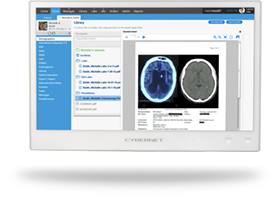Patient treatment is incredibly complex in the modern era, involving not just the patient's provider but also medical staff, office personnel, insurance agencies, and government entities. Such intimate involvement makes all documentation related to patient care, such as electronic health records displayed on medical computers, vitally important. Clinical documentation improvement has arisen to ensure such information is recorded to reflect the given patient's care as accurately as possible.
- Clinical Documentation Improvement: A Breakdown
- Importance of Clinical Documentation Improvement
- CDI Common Challenges and How to Overcome Them
- Best Practices for Implementing Clinical Documentation Improvement
Clinical Documentation Improvement: A Breakdown
In simplest terms, clinical documentation improvement (CDI) is the process of ensuring healthcare documentation is complete, clear, accurate, and consistent. "Documentation" encompasses everything from patients' electronic health records (EHRs) to the codes used by medical coders and billers, as well as the SOAP notes of providers.
Documentation is both generated and used in every part of medicine. Thus, virtually every department is, in one form or another, involved in CDI programs, striving to ensure that each piece of information accurately portrays patient care provided at the time. And in today's modern medicine, advanced technologies like medical AI computers rely heavily on the accuracy of documentation to perform as intended.
Importance of Clinical Documentation Improvement
In medicine, CDI acts like both the carrot and the stick. Medical facilities that follow the programs can expect to see improved outcomes from workflows affected. Reimbursements from medical insurance companies and the government may arrive faster or in full.
Facilities that don't follow can suffer severe consequences. The healthcare sector is highly regulated, and CDI includes many compliance programs. Failure to comply can result in injured patients due to faulty information in their EMR, or artificial intelligence giving a diagnostic error based on biased input.
Improved Patient Care
Clear and precise documentation enables providers to make more accurate diagnoses of their patients' medical conditions, which in turn leads to more effective treatment plans and improved patient outcomes. A holistic understanding of these conditions ensures that treatment is both safe for the patient and cost-effective for the medical group.
Accurate Reimbursement
CDI ensures that all the patient's medical conditions are thoroughly documented, from the provider's SOAP notes to the codes assigned by medical coders and billers. Such thorough compliance improves the likelihood of prompt payment from insurance companies and government agencies, while reducing the risk of claim denials and potential audits.
Regulatory Compliance
As mentioned earlier, healthcare is a highly regulated sector, with rules governing everything from what qualifies as a medical device to the protection of patient information, per the Health Insurance Portability and Accountability Act (HIPAA). Comprehensive and complete documentation can help medical groups avoid compliance violations and their associated costs, which range from fees to jail time.
Enhanced Data Quality
The documentation used in medical groups isn't just used for clinical purposes, like aiding in medical diagnosis. The data is valuable for various purposes outside the day-to-day workflow. Hospitals, for example, can estimate peak use of the operating theatre and plan surgeons' schedules accordingly. Pharmaceutical companies may use patients' medical conditions in the development of new treatments once personal information has been scrubbed from data. The scrubbed data can also be used to train the large language models (LLM) used by AI in understanding human language inputs. CDI ensures that the data used in any of these matters is of the highest quality possible.
CDI Common Challenges and How to Overcome Them
Medical groups seeking to benefit from clinical documentation improvement should be aware of the challenges involved in integrating CDI into their workflow. Fortunately, each one has solutions to resolve the issue.
Provider Resistance
Providers and other regular EHR users may find the technology too burdensome to use. The result is low-quality data, as records are incomplete, forms are not properly filled out, and so on. In response, EHR templates should be developed to minimize documentation. Providers should receive a crash course on their use, with EHR system experts readily available to answer queries and offer refresher courses.
Query Fatigue
To ensure documentation is as complete as possible, many CDI programs request additional information or clarification from providers regarding their submitted records. This can lead to query fatigue, as the sheer volume of alerts, requests, and updates can result in a lack of response, incomplete records, and even provider burnout. CDI programs, to reduce such risks, should only query when the issue is major and part of the medical group's overall goals (example: compliance with governmental regulations).
Technology Gaps
Data silos affect healthcare and, in turn, CDI efforts by forcing reviews of the same information across multiple sources. Example: Hospital admission uses a different EMR than the surgical department. Medical groups should strive to consolidate such sources under a single platform or within a network where their data can be modified and standardized.
Measuring Impact
CDI audits need to have specific goals; otherwise, they're (expensive and time-consuming) busywork. All CDI efforts should be tied to a specific goal, whether financial, quality, or operational.
Best Practices for Implementing Clinical Documentation Improvement
So, how does a healthcare organization go about implementing CDI in its workflows? While a detailed step-by-step checklist varies per group (and even department), the following best practices can be applied to most organizations.
Assemble the CDI Team
Specifically, hire or designate CDI specialists with clinical backgrounds. They are usually registered nurses (RN) certified in clinical documentation improvement. Medical coders with similar certifications may also be considered; however, they lack the same experience in reading EMRs as RNs.
Representatives from providers, case managers, pharmacists, and other nursing and coding departments should have some buy-in.
Establish Clear CDI Goals
Is the goal to ensure compliance? And if so, with which regulations? Ensure the best outcome for each treated patient? Or a greater focus on growing the medical group's revenue cycle? These and more require different kinds of documentation, steps in their review, and – most importantly – key performance indicators (KPI).
Select Technology and Reporting Tools
CDI teams have many technologies at their disposal thanks to the digital transformation of healthcare. Automation tools, natural language processing, and artificial intelligence, when run on AI computers, can rapidly review massive amounts of documentation, identifying gaps in records, missing prescriptions and codes, and find other forms of inaccuracies. CDI teams can then focus on more complex cases and issues.
Roll Out Plans
This last practice implements the CDI program throughout the healthcare organization. It's not done all at once; rather, in small, systematic steps. The CDI team conducts a pilot program first to ensure that plans and technology achieve the desired goal. The program is then rolled out to target departments, with their outcomes measured and reviewed. This process is repeated until every involved department is included and all goals are met.
Streamline Clinical Documentation Improvement Through Cybernet Computers
Clinical documentation improvement involves a systematic review of a medical group's most critical documentation, including patients' electronic medical records, providers' notes, and billing invoices, among other relevant records. Many are crucial to group operations, such as compliance, so the goal of CDI is to ensure each piece is complete, clear, accurate, and consistent.
Is your healthcare group looking to roll out CDI programs across its facilities? Contact Cybernet Manufacturing for more info. We'll be happy to review how our medical computer lineup is optimized for the healthcare setting, featuring medical-grade components for safe, near-patient use, as well as HIPAA compliance to protect patient documentation. As an original equipment manufacturer, we have full control over our design and manufacturing processes, enabling us to tailor any of them to meet the exact needs of your CDI team.

